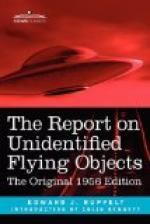When I later found out that the press had been dismissed on the grounds that the procedures used in an intercept were classified, I knew that this was absurd because any ham radio operator worth his salt could build equipment and listen in on any intercept. The real reason for the press dismissal, I learned, was that not a few people in the radar room were positive that this night would be the big night in UFO history—the night when a pilot would close in on and get a good look at a UFO—and they didn’t want the press to be in on it.
But just as the two ’94’s arrived in the area the targets disappeared from the radarscopes. The two jets were vectored into the areas where the radar had shown the last target plots, but even though the visibility was excellent they could see nothing. The two airplanes stayed around a few minutes more, made a systematic search of the area, but since they still couldn’t see anything or pick up anything on their radars they returned to their base.
A few minutes after the F-94’s left the Washington area, the unidentified targets were back on the radarscopes in that same area.
What neither Major Fournet nor I knew at this time was that a few minutes after the targets left the radarscopes in Washington people in the area around Langley AFB near Newport News, Virginia, began to call Langley Tower to report that they were looking at weird bright lights that were “rotating and giving off alternating colors.” A few minutes after the calls began to come in, the tower operators themselves saw the same or a similar light and they called for an interceptor.
An F-94 in the area was contacted and visually vectored to the light by the tower operators. The F-94 saw the light and started toward it, but suddenly it went out, “like somebody turning off a light bulb.” The F-94 crew continued their run and soon got a radar lock-on, but it was broken in a few seconds as the target apparently sped away. The fighter stayed in the area for several more minutes and got two more lock-ons, only to have them also broken after a few seconds.
A few minutes after the F-94 over Newport News had the last lock-on broken, the targets came back on the scopes at Washington National.
With the targets back at Washington the traffic controller again called Air Defense Command, and once again two F-94’s roared south toward Washington. This time the targets stayed on the radarscopes when the airplanes arrived.
The controllers vectored the jets toward group after group of targets, but each time, before the jets could get close enough to see anything more than just a light, the targets had sped away. Then one stayed put. The pilot saw a light right where the ARTC radar said a target was located; he cut in the F-94’s afterburner and went after it, but just like the light that the F-94 had chased near Langley AFB, this one also disappeared. All during the chase the radar operator in the F-94 was trying to get the target on his set but he had no luck.




